Monsteras are some of the most popular house plants. However, they can be temperamental. This article will answer the following question – How do you fix droopy Monstera?
One of the most prevalent reasons of monstera plant’s drooping leaves is improper watering.
Droopy leaves may be caused by either overwatering or underwatering. Other reasons of drooping monstera leaves include insufficient lighting, fertilizer issues, stress, and insects.
Most of the time, it is noticed that drooping or curled leaves are the consequence of poor watering. They will droop in both circumstances.
If you’re watering properly, the causes might be overfertilization, too much sunlight, or poorly draining soil.
Don’t worry if your plant’s leaves were solid and shiny a few days ago but are now looking sad. There are simple remedy solutions for maintaining their great huge leaves.
Let’s get straight to it.
Read More: Monstera Leaves Care – A Complete Guide
Table of Contents
Why is my Monstera droopy?
Droopy leaves in mostera may be caused by a variety of factors. These are some of them:
- Watering problems
- Inadequate lighting
- Poorly drained soil
- Pest infestation
- Temperature fluctuation
- Overfertilization
- Low relative humidity
- The wrong size of the pot
Let us have a look at what we can do to resolve these challenges.
Watering problems
Reassess if you are overwatering or underwatering.
Underwatering
- Soak your Monstera in a tray of water, but don’t submerge the pots. The plant will absorb water via drainage holes using the capillary method.
- After some time, check the soil to see whether it is wet or dry. A gentle mist from above will enable moisture to be absorbed by the soil if necessary. You should be able to keep the plant in water for around an hour.
- Remove the plant from the tray and allow it to drain all of the extra water it has absorbed. Your plant should now be back where it was before.
If you want a simple and quick way, just water your plant fully from the top, continue watering until the soil is damp, and then let the surplus water drain entirely through the drainage holes.
Aerial roots may also be directed to the soil so that they get adequate water.
Overwatering
Due to their epiphytic nature, monsteras are less tolerant of overwatering than underwatering.
In this instance, your plant needs time to absorb the extra water that has already drowned it.
- Wait until the soil has dried completely before watering it again.
- Repotting the plant may be necessary if your Monstera continues to show no improvement.
- To prevent overwatering or watering while the soil is already saturated, always dip your finger into the soil before watering.
- Before watering, aerate the soil (you may use a soil sleuth for this).
Insufficient lighting
If you remember to use bright indirect light, your plant will never suffer from poor lighting. They will also thrive well in low to medium light.
Your plant may be suffering because it has been exposed to the blistering sun for a lengthy period of time. Fluorescent lighting will also be welcomed by them. Allow your plant to soak up the sun by placing it near an indirect light source!
They should be placed near a window or balcony so they may get both morning and evening sun. Keep your plant at least a few feet away from direct sunlight to lessen the intensity of the light that reaches it.
Poorly drained soil
Roots and plants might suffer from poor soil drainage if the mix is unable to absorb water and pushes out the air entirely.
It is simple to make a soil mixture that holds water while being light and breathable. The following is an example of what you can do.
- Garden soil accounts for about 50% of the total.
- Cocopeat and peat moss make up about 30% of the total.
- Perlite/Coco chips make up about 10% of the total.
- Compost makes up 10% of the total.
Insect infestation
You don’t have to have a degree in botany to fix this problem. Simply opening your eyes will reveal the potential solutions.
One of the earliest indicators of pest infestation is drooping leaves. Controlling them may be accomplished in a variety of ways. As an organic fanatic, we would recommend the safest, most effective, and non-toxic ways for your plants.
- Wash the plant thoroughly with a steady flow of cold water, ensuring no surplus water rests on the plant’s leaves or soil. This will primarily aid in the removal of pests and honeydew produced by them.
- For organic gardening, neem oil is ideal. It will not hurt your plants. It will kill the insects by getting into their bloodstreams and destroying them.
- 1 tablespoon of neem oil diluted in 2 cups of water, sprayed all around the plant. Repeat every several days until the condition is entirely resolved.
Other methods include:
- Insecticidal soap
- Hand-picking
- Horticulture oil
- Rubbing alcohol
- Hydrogen peroxide
Regardless of what you choose to use, remain persistent in your efforts to manage it.
The most important thing is Persistence!
If you like, you may apply a chemical pesticide, but we don’t want you to use it since it is hazardous to your plant. For those who insist on using them, please follow the provided instructions.
Temperature change
Freezing temperatures are usually the worst for your plant’s growth. If it’s colder than 50 degrees Fahrenheit, they won’t feel at home, so provide them with the settings they’re used to at home.
Place them near a furnace or wood stove to raise the temperature surrounding them.
When the wind is blowing, the foliage gets dried off, which means the plant needs more water, thus it will need to be watered more often.
To ensure that your plant continues to thrive, try to maintain it in a warm location.
Overfertilization
While a good dosage of fertilizer is beneficial, overfeeding may be harmful to your monstera’s growth.
Because your monsteras are fast-growing plants, fertilizing them every two weeks to once a month throughout the summer (the growing season) is a fine decision.
Fertilizer should be diluted with water before use. Choose an organic fertilizer that suits your needs.
Fertilization should be reduced or avoided entirely during the winter.
Low humidity level
If your plant is showing indications of dehydration, keep a humidifier near you. If you are following all of the instructions, but your Monstera plant is still not blooming, humidity might be the problem.
- The use of a humidifier is highly recommended during the drier months.
- You may cluster your Monstera plant with other houseplants to ensure that they all get the same amount of humidity.
- It is also feasible to maintain humidity by misting to a certain degree, although this is not always practical. Misting once a week is sufficient.
Pot size
- If you have a small pot, the soil will dry up much faster. It is thus suggested that you water your Monstera plant once a week in order to keep the soil moist.
- If you have a large pot, you will need to water it more often since the soil will retain water for a longer period of time. Watering should be done once every two weeks on a regular basis.
Inspect the soil moisture before following any given procedure, and water only if necessary.
There is a possibility that your monstera plant leaves will droop if you do not follow the instructions above.
A few recommendations for raising a healthy monstera plant.
For those of us who like plants, the Monstera is a wonderful choice. The root system is the most important consideration if you’re going for the big, thick foliage.
Examine the root system of the plant before purchasing to see whether it requires a larger pot or is happy in its current pot.
If the roots are gigantic, planting in a larger container will encourage the roots to grow larger, resulting in larger, more glossy leaves. Change the container size as the plant’s root system expands.
Keeping the soil moist is essential for your monstera to grow, and ceramic, terracotta, and wooden pots are all great choices for doing so.
Bottom watering can assist you in providing enough moisture to your Monstera plant. So give it a go!
After that, place the plant in a location where it will get plenty of light but not direct sunlight, maintain the humidity and temperature levels high, monitor the plant’s water requirements, and fertilize it regularly throughout the summer months.
Cleaning the leaves on a regular basis will allow the plant to photosynthesise more easily and preserve its brightness.
Rotating your plant on a regular basis can help it grow evenly and avoid sagging.
Make sure that the water you use for your monstera is safe to drink. You can filter the water or let the water sit for a few hours.
Continue trimming if you notice your Monstera plant is becoming too bushy to manage. This will also reduce the strain on the soil, which will help it to keep healthy leaves.
Conclusion
How do you fix droopy monstera?
- Don’t overdo anything that may stress your plant and make it difficult for it to grow.
- As well as being easy to care for, they also clean the air in your home. They are very useful.
- Respect a few easy guidelines and make use of your experience in determining what they need and how much.
- If you pay attention to their needs, they will return the favor.



